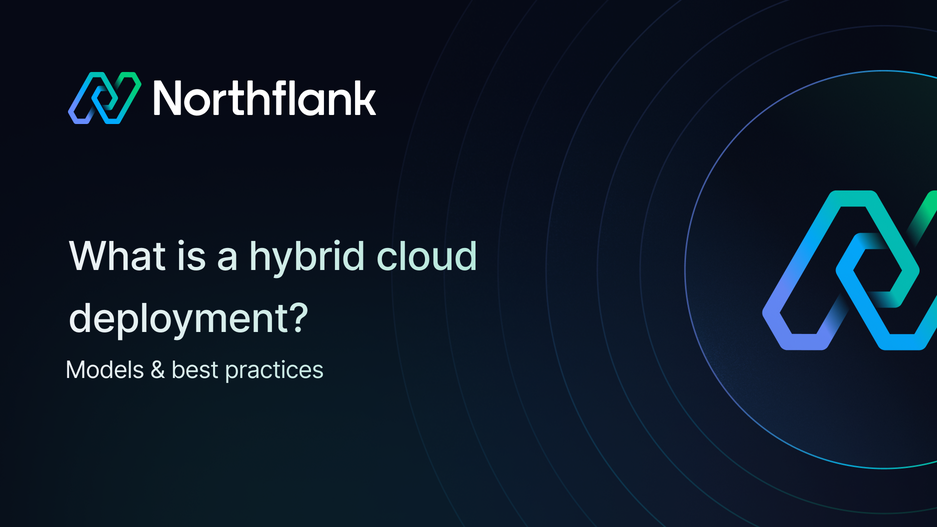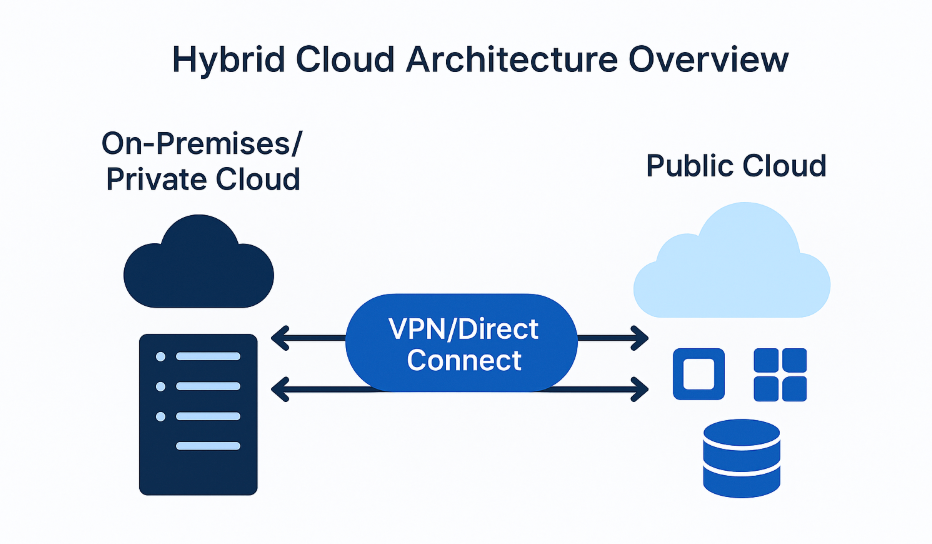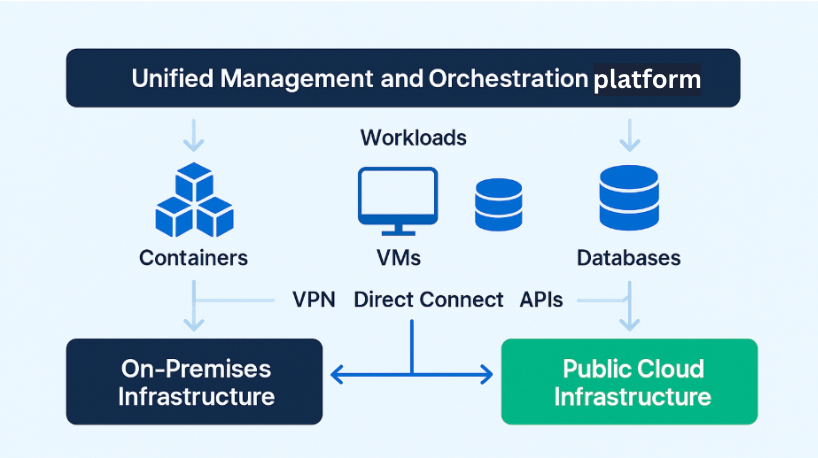

What is a hybrid cloud deployment? Models & best practices
Hybrid cloud deployment combines public cloud services with private cloud or on-premises infrastructure into a unified, interconnected environment. Read on to learn what hybrid cloud deployment is, how it works, the key benefits and challenges, and when to choose hybrid cloud over other deployment models.
Hybrid cloud deployment is an infrastructure approach that integrates two or more distinct computing environments: typically a public cloud platform (like AWS, Google Cloud, or Azure) with either a private cloud or on-premises data center.
So, rather than simply running separate clouds side by side, a true hybrid cloud creates tight interconnection between these environments. This allows data and applications to move smoothly across them as a unified system.

Take a financial services application as an example. You keep customer financial data and transaction processing in your private data center where you have complete control and can meet strict regulatory requirements. At the same time, you run your customer-facing web application and marketing analytics in the public cloud where you can scale quickly during peak times.
This approach lets you balance security requirements, compliance needs, existing infrastructure investments, and the benefits of cloud capabilities without having to choose one over the other.
You need to understand how hybrid cloud fits within the broader cloud deployment options to know when it's the right choice for your needs. Let's look at the four primary cloud deployment models:
Public cloud services like AWS, Google Cloud, and Microsoft Azure are shared computing platforms operated by third-party providers who offer resources over the internet. You share infrastructure with other customers but get instant scalability with pay-as-you-go pricing and no upfront costs.
A private cloud is dedicated infrastructure used exclusively by your organization, either on-premises or hosted by a provider. You get complete control and customization, but handle all the management and costs.
Hybrid cloud combines public and private environments into one integrated platform. You keep sensitive workloads private while using public cloud for scalability.
Multi-cloud means using multiple public cloud providers simultaneously, like running some workloads on AWS and others on Google Cloud. Multi-cloud differs from hybrid cloud because it doesn't necessarily involve private infrastructure.
Hybrid cloud deployment relies on three key components: network connectivity, data synchronization, and unified management.
Network connectivity is the foundation. Your environments connect through:
- Virtual Private Networks (VPNs) for secure, encrypted communication
- Dedicated connections like AWS Direct Connect, Azure ExpressRoute, or Google Cloud Interconnect for better performance
- APIs and service meshes for application-level integration

Once your environments are connected, data synchronization keeps everything consistent across them. Data might be replicated between storage locations, cached strategically, or kept in one place with access through APIs.
Finally, unified management brings separate environments together into one cohesive hybrid cloud. Modern cloud infrastructure management platforms give you a single control plane to deploy and manage workloads anywhere. Container technologies like Kubernetes let developers package applications once and deploy them across any infrastructure.
Platforms like Northflank abstract this complexity through its Bring Your Own Cloud (BYOC) capabilities, letting you deploy across AWS, GCP, Civo, Oracle, Azure, and on-premises infrastructure from one unified interface.
There are several advantages that come with hybrid cloud architecture for organizations, balancing control, cost, and flexibility.
Hybrid cloud enables you to migrate to the cloud from on-premise at your own pace. You can move workloads incrementally instead of a risky "big bang" migration, maintaining critical systems on-premises while testing new ones in the cloud.
If your organization operates in a regulated industry such as finance, healthcare, or government, hybrid cloud addresses a critical challenge. You can keep sensitive data in your private environment where you control security and ensure compliance with regulations like HIPAA or GDPR, while using public cloud for non-sensitive applications.
Hybrid cloud lets you match workloads to the most economical environment. You can leverage existing on-premise investments instead of abandoning them, use public cloud for variable or peak demand (cloud bursting), and take advantage of cloud credits or committed-use discounts.
Running workloads across multiple environments creates natural redundancy. If one environment has issues, critical applications can fail over to the other, strengthening business continuity and reducing the risk of complete outages.
You don't have to choose between control and modern services. You can experiment with machine learning, big data analytics, or serverless computing for appropriate workloads while maintaining traditional applications on familiar infrastructure.
While hybrid cloud offers significant benefits, watch out for some of these challenges:
Managing multiple environments with different APIs, tools, and processes creates operational complexity. Your team needs expertise across various platforms, and ensuring consistent security policies and configurations across environments requires careful orchestration.
Hybrid cloud expands your attack surface. Data moving between environments needs encryption, and you must maintain consistent security postures across both private and public infrastructure. However, with proper architecture and zero-trust security principles, hybrid cloud can be very secure.
Your hybrid cloud is only as reliable as the network connecting your environments. Latency between environments can impact application performance, especially for workloads requiring frequent communication across clouds. Network bandwidth, reliability, and associated costs become critical factors in your architecture design.
While hybrid cloud can optimize costs in many scenarios, it can also increase overall spending if not managed carefully. You're maintaining infrastructure in multiple locations, potentially duplicating data storage, and paying for network connectivity and specialized management tools.
How do you avoid these challenges?
That's where platforms like Northflank come in handy. With methods like Northflank's Bring Your Own Cloud (BYOC) model, you can deploy and manage workloads across AWS, GCP, Civo, Oracle, Azure, and on-premise infrastructure from a single control plane.
This means you don't need to switch between multiple vendor consoles and APIs, as everything is managed through a single unified interface.
Now that you understand the benefits and challenges, let's look at when a hybrid cloud is the right choice compared to other options.
| Deployment model | Best used when | Avoid when |
|---|---|---|
| Hybrid cloud | You need data sovereignty or compliance; gradual cloud migration is preferred; workloads have different security needs | You're a startup with no existing infrastructure; all workloads are similar; network latency would impact critical applications |
| Public cloud | You're building new applications; you need maximum scalability; you want minimal infrastructure management | You have strict data residency requirements; you must maintain complete control; compliance mandates private infrastructure |
| Private cloud | You have extremely sensitive data; regulatory requirements prohibit public cloud; you need complete control over the stack | You need rapid scaling; you want to minimize capital expenditures; you lack infrastructure expertise |
| Multi-cloud | You want to avoid vendor lock-in; you need geographic distribution; you want best-of-breed services from multiple vendors | You have limited DevOps resources; you want to minimize complexity; you're just starting cloud adoption |
You've seen the benefits and challenges of hybrid cloud deployment.
Northflank addresses the complexity challenge by providing a unified platform that works seamlessly across any infrastructure.
Through our Bring Your Own Cloud (BYOC) capabilities, you can deploy to AWS, GCP, Civo, Oracle, Azure, or on-premise Kubernetes clusters.
You can interface with the platform either through the UI, CLI, or API, so your team can focus on shipping features instead of managing infrastructure complexity.
Start with Northflank's free tier or book a demo with our engineering team to discuss your specific hybrid cloud requirements.